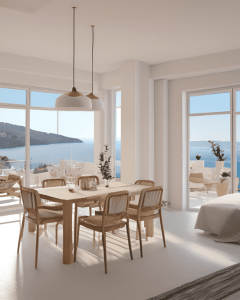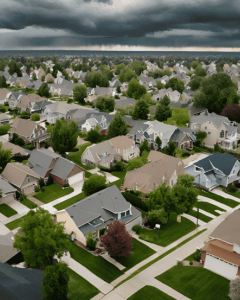US: Surge in Zombie Properties Evident as Foreclosure Activity Escalates in 2023
Explore the alarming rise of zombie properties in the United States, mirroring the growing foreclosure activity in 2023. Gain a comprehensive understanding of this unsettling trend, its implications for the housing market, and the potential challenges it poses for communities nationwide. Stay informed with our in-depth analysis in this thought-provoking article.
According to ATTOM's recently released third-quarter 2023 Vacant Property and Zombie Foreclosure Report, the United States is facing a rising number of vacant residential properties, commonly referred to as "zombie properties." The report reveals that 1.3 million (1,277,612) homes across the nation, accounting for 1.3 percent or one in 79 homes, are currently vacant. This figure remains consistent with the second quarter of this year.
The report also highlights a concerning trend in foreclosure activity, indicating that 315,425 residential properties are in the process of foreclosure in the third quarter of this year. This represents a 1.3 percent increase from the second quarter of 2023 and a significant 16.6 percent increase from the third quarter of 2022. The lifting of the nationwide moratorium on pursuing delinquent homeowners in the middle of 2021 has led to a growing number of homeowners facing possible foreclosure, resulting in the surge of foreclosure activity.
Among these pre-foreclosure properties, approximately 8,800 are categorized as zombie foreclosures, referring to properties abandoned by their owners before entering the foreclosure process. This number reflects a slight increase of 0.3 percent from the previous quarter and a notable 13.9 percent increase from the same period last year. While this marks the sixth consecutive quarterly gain, the proportion of zombie foreclosures remains relatively small compared to the total stock of 101.6 million residential properties in the nation.
The United States' housing market boom, which has more than doubled the national median home value since 2012, has notably contributed to the limited presence of zombie foreclosures in most areas. The escalating home prices have continued to drive home equity and selling profits, offering delinquent homeowners greater incentives to avoid foreclosure and explore alternative options to address their financial challenges.
Despite the upward tick in zombie foreclosures, evidencing an upward trend in recent quarters, the associated problems remain relatively minimal. The third quarter of 2023 witnessed 8,782 residential properties vacated by their owners, a slight increase compared to the previous quarter's figure of 8,752 and a significant rise from 7,707 in the third quarter of 2022. While 19 states experienced quarterly growth in the number of zombie properties, 28 states reported an annual increase. The states with at least 50 zombie properties experiencing the highest growth rates from the second quarter of 2023 to the third quarter of 2023 include Missouri (51 percent increase, from 35 to 53), Maryland (22 percent increase, from 188 to 229), Oklahoma (15 percent increase, from 173 to 199), Connecticut (13 percent increase, from 77 to 87), and Pennsylvania (11 percent increase, from 401 to 446). Conversely, Texas, Michigan, Georgia, Kentucky, and Nevada experienced decreases in zombie foreclosures during the same period.
Looking at overall vacancy rates, the third quarter of 2023 saw a relatively stable situation, with the vacancy rate for all residential properties in the U.S. remaining unchanged. The current rate stands at 1.26 percent, representing one in 79 properties, similar to the rates of the second quarter of 2023 (1.27 percent) and the third quarter of the previous year (1.28 percent). States with the highest vacancy rates for all residential properties include Oklahoma (2.26 percent), Kansas (2.13 percent), Alabama (2.03 percent), Indiana (2.02 percent), and West Virginia (2 percent). Conversely, New Jersey, New Hampshire, Vermont, Idaho, and North Dakota reported the smallest overall vacancy rates.
In examining further details from the third quarter of 2023, we find that several metropolitan statistical areas (MSAs) in the United States experienced relatively high rates of properties facing possible foreclosure and zombie foreclosures. Among the MSAs with at least 100,000 residential properties, the cities with the highest zombie foreclosure rates in the foreclosure process are Cedar Rapids, IA (12.5 percent), Peoria, IL (10.8 percent), Indianapolis, IN (8.9 percent), Fort Wayne, IN (8.8 percent), and Youngstown, OH (8.3 percent).
Additionally, apart from Indianapolis, major metropolitan areas with over 500,000 residential properties and at least 100 homes facing foreclosure also witnessed elevated zombie-foreclosure rates. These cities include Cleveland, OH (7 percent), St. Louis, MO (6.5 percent), Baltimore, MD (5.8 percent), and Pittsburgh, PA (5.7 percent).
Zooming out to an investor perspective, the United States boasts approximately 23.4 million investor-owned homes in the third quarter of 2023. Among these, approximately 836,000 properties remain vacant, accounting for a vacancy rate of 3.6 percent. States recording the highest levels of vacant investor-owned homes include Indiana (6.9 percent), Oklahoma (6.2 percent), Alabama (6.1 percent), Illinois (6 percent), and Ohio (5.9 percent).
Analyzing bank-owned homes reveals that out of the roughly 14,800 foreclosed properties in the U.S. during the third quarter of 2023, approximately 15.8 percent are vacant. Examining states with at least 50 bank-owned homes, Kansas, Iowa, Ohio, Michigan, and Indiana exhibit the highest vacancy rates.
Transitioning to the county-level analysis, the highest zombie-foreclosure rates are concentrated in select counties. In Peoria County, IL (12.3 percent), Baltimore County, MD (12.2 percent), Marion County (Indianapolis), IN (12.1 percent), Broome County (Binghamton), NY (11.7 percent), and Lake County, IN (9.4 percent), zombie properties represent a significant portion of all homes in the foreclosure process.
Furthermore, among the 435 counties in the U.S. with at least 50,000 residential properties, Broome County (Binghamton), NY, Peoria County, IL, Suffolk County, NY (eastern Long Island), Cuyahoga County (Cleveland), OH, and Tazewell County, IL (outside Peoria) exhibit the highest ratio of zombie foreclosures to total properties.
Analyzing zip codes further unveils regional trends in zombie property proportions. Out of the 50 zip codes with the highest percentages of overall homes categorized as zombie properties, New York, Ohio, and Illinois dominate the list, including seven zip codes in Cleveland, OH. Notable ratios include zip codes 10993 in Rockland County (West Haverstraw), NY (one in 191 homes); 73554 in Greer County (Mangum), OK (one in 222); 44108 in Cleveland, OH (one in 255); 44127 in Cleveland, OH (one in 270); and 13754 in Broome County (Deposit), NY (one in 286).
In conclusion, the growing number of zombie properties in the United States reflects the impact of escalating foreclosure activity as a result of the national moratorium being lifted. While the increase in zombie foreclosures is evident, it remains relatively small compared to the nation's total stock of residential properties. Factors such as the housing market boom and rising home prices have incentivized delinquent homeowners to explore alternatives to foreclosure, contributing to a relatively stable housing market.
US: Surge in Zombie Properties Evident as Foreclosure Activity Escalates in 2023
Greece Real Estate Market: Rise of Serviced Apartments
Explore the growing demand for serviced apartments in central Athens, where integrated hospitality services attract savvy investors in the Greece real estate market.
Explore the growing demand for serviced apartments in central Athens, where integrated hospitality services attract savvy investors in the Greece real estate market.
Read moreHome Prices Hit by Climate Change, J.P. Morgan Warns
J.P. Morgan analysts reveal a negative link between climate risk and home price appreciation. Explore the emerging trends and their impact.
J.P. Morgan analysts reveal a negative link between climate risk and home price appreciation. Explore the emerging trends and their impact.
Read moreRenting in Spain: Prices Finally Decline
The cost of renting in Spain trends downwards, averaging €13/m². Discover insights on this shift after years of steep increases.
The cost of renting in Spain trends downwards, averaging €13/m². Discover insights on this shift after years of steep increases.
Read moreRise of Cash Purchases Outside London: A New Trend
Explore the growing trend of cash purchases outside London and its implications for the property market and economic landscape.
Explore the growing trend of cash purchases outside London and its implications for the property market and economic landscape.
Read moreCanada Real Estate Market: Rents Drop for First Time in over 3 years
For the first time in over three years, average asking rents in Canada fell 1.2% in October, reaching $2,152, according to Rentals.ca.
For the first time in over three years, average asking rents in Canada fell 1.2% in October, reaching $2,152, according to Rentals.ca.
Read moreFewer Than 2% of Dutch Homes Sold to International Buyers
Analyze the decline in international purchases of Dutch houses, revealing key factors influencing this trend and its effects on the housing market.
Analyze the decline in international purchases of Dutch houses, revealing key factors influencing this trend and its effects on the housing market.
Read moreDonald Trump’s Victory May Boost London Property Demand
Knight Frank analyzes how Donald Trump’s election win could increase demand for prime London properties. Discover the potential market shifts.
Knight Frank analyzes how Donald Trump’s election win could increase demand for prime London properties. Discover the potential market shifts.
Read moreGerman Investors Fuel Growth in Greek Real Estate Market
Discover how German-speaking house buyers are revitalizing Greece's realty market, driving demand and investment in stunning properties.
Discover how German-speaking house buyers are revitalizing Greece\'s realty market, driving demand and investment in stunning properties.
Read moreLisbon: 11th City for Rising Luxury House Prices
Lisbon's luxury housing prices increased by 5.6%, outpacing Madrid, Seoul, and Zurich, marking it as a key player in the global real estate market.
Lisbon\'s luxury housing prices increased by 5.6%, outpacing Madrid, Seoul, and Zurich, marking it as a key player in the global real estate market.
Read more














